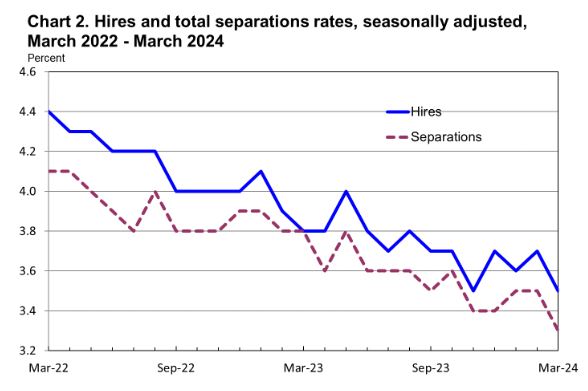
Replacing an employee is an incredibly expensive endeavor, and there’s just no way around that.
From the costs of recruiting, training, and onboarding, to the inevitable loss of productivity that takes place, no matter how you slice it, it’s going to cost you a pretty penny.
In my experience, many business owners don’t understand the true cost of turnover, and as a result, they often hire and fire much too quickly and carelessly, typically when trying to plug a hole after someone leaves or their business expands.
But if they truly understood the cost of replacing an employee, I think a lot of business owners wouldn’t be acting so hastily.
With that in mind, I want to explore the true cost of turnover, explaining why it’s so expensive and what you can do to minimize how much it’ll cost your business.
So, if you’re asking yourself, “What is the cost of turnover?”, trying to determine the cost of replacing an employee, or want to reduce the impact turnover has on your bottom line, then this is an article you’re not going to want to miss.
Why Is the Cost of Turnover so Expensive?
As an employer, hiring and firing will probably be one of your biggest expenses.
Fortunately, as you can see from the graph below, according to U.S. Department of Labor data, the national average employee turnover rate has been declining over the last couple of years, finally recovering from the turmoil that took place during the pandemic.

But while the overall U.S. turnover rate has been steadily decreasing, that doesn’t mean turnover has gotten any less expensive.
According to data from the Society for Human Resource Management (SHRM), on average, it costs about $4,700 to hire someone, which is a lot, but that’s still lowballing it.
If you add in the price of using a professional recruiting firm, it’s going to cost you a lot more because you’ll be paying them the equivalent of about 20-40 percent of that employee’s salary immediately after hiring them.
Moreover, many of the employers surveyed by SHRM said the total cost to hire a new employee can be up to three to four times the position’s salary, which means if you’re hiring for a job that pays $50,000 per year, you could end up spending $150,000 or more just to fill the position.
Furthermore, despite this trend toward lower average turnover rates, many people are expecting to see higher employee turnover this year.
For example, an Express Employment Professionals poll found that 33 percent of U.S. hiring managers anticipate employee turnover at their company to increase over the next year.
This will cost them an average of $36,295 annually, with more than 20 percent saying that number will likely climb to $100,000 or more.
So, as you can see, even with the U.S. turnover rate continuing to go down, the cost of turnover remains significantly expensive.
But why is turnover so expensive?
Truth be told, many different things affect the cost of hiring and firing, but some will tend to be more influential than others.
With that in mind, below I’ve listed what I believe are the main factors that contribute to the cost of employee turnover.
Recruitment Costs

Recruitment is often the first step in replacing an employee who has left.
It involves various expenses, including advertising the job vacancy on relevant platforms, engaging with recruitment agencies, and conducting background checks and drug tests.
These costs can quickly add up, particularly if the position requires specialized skills or experiences that are challenging to find.
Moreover, the hours spent by HR personnel and hiring managers on reviewing resumes, conducting interviews, and coordinating the recruitment process can add up quickly.
Training and Onboarding
Once a suitable candidate is hired, the process of integrating them into your organization begins.
That being said, training and onboarding programs are essential to ensure that the new employee understands their role, responsibilities, and your company’s culture.
This process incurs costs related to training materials, software licenses, and the time spent by trainers and existing employees who have to mentor the newcomer.
Additionally, if the position requires technical skills or knowledge specific to your organization, external training programs or certifications may be necessary, which can further increase the cost of onboarding.
Productivity Loss
Employee turnover can disrupt workflow and productivity within your organization.
When a skilled employee leaves, their departure creates a void that must be filled either by redistributing tasks among existing staff or by hiring and training a replacement.
During this transition period, productivity may suffer, as remaining employees adjust to new roles and the new hire gets acquainted with their responsibilities.
Delays in project timelines, missed deadlines, and decreased output are common consequences of this kind of productivity loss, all of which can affect your bottom line.
Lost Knowledge and Expertise
Experienced employees accumulate valuable knowledge and expertise over time, which becomes embedded in your organization’s processes, systems, and culture.
But when these employees leave, they take their knowledge with them, leaving behind a gap that is often not easily filled.
This loss of knowledge can result in inefficiencies, errors, and missed opportunities, as new employees struggle to keep up.
Moreover, the departure of key employees may disrupt ongoing projects, leading to additional costs and setbacks for your business.
Impact on Morale
High turnover rates can have a detrimental effect on employee morale and engagement.
When employees witness their colleagues leaving frequently, it creates a sense of instability and uncertainty within the workplace.
Morale may further deteriorate if employees think that their contributions are not valued or if they feel overburdened by the increased workload resulting from turnover.
Low morale can contribute to absenteeism, decreased productivity, and higher turnover rates, creating a vicious cycle that can be costly for you to break.
Customer Impact
In customer-facing roles, employee turnover can directly impact the quality of service provided to clients or customers.
Experienced employees develop relationships with clients, understand their needs and preferences, and provide personalized solutions that contribute to their satisfaction and loyalty.
But when these employees leave, you may be saddled with service disruptions, errors, or inconsistencies that can undermine the trust you’ve worked so hard to build.
As a result, dissatisfied customers may take their business elsewhere, resulting in lost revenue and damage to your organization’s reputation.
Severance and Exit Costs
Depending on the circumstances of the employee’s departure, your organization may incur additional costs such as severance pay, accrued vacation or sick leave, and other exit-related expenses.
These costs can vary depending on factors such as the employee’s length of service, contractual obligations, and legal requirements.
Moreover, the process of offboarding departing employees involves administrative tasks such as collecting company property, updating records, and communicating the departure to relevant stakeholders, all of which require time and resources.
And in some cases, especially for remote employees, retrieving home office equipment like laptops and monitors can prove to be an expensive problem.
Reputation Damage
High turnover rates can tarnish your business’ reputation as an employer people want to work for.
For instance, potential candidates may be deterred from applying for vacant positions if they think your business is unstable or if they read negative reviews from former employees.
Similarly, customers and clients may question your reliability and commitment to quality if they observe frequent turnover.
At any rate, a damaged reputation can make it challenging for you to attract and retain top talent, which makes recruiting more expensive and your business less competitive.
What Can I Do to Lower the Cost of Turnover?

Now that you have a better understanding of the true cost of turnover, you’re probably wondering what you can do to lower that cost.
Luckily, there’s a lot you can do to mitigate turnover and minimize the cost of replacing employees.
With that in mind, below I’ve offered some advice on what you can do to hire the right people, keep more of your employees for longer, and ultimately, lower the cost of turnover.
And if you want to learn more about what you can do to retain your employees, you should check out my article, Inflation Is Affecting Employee Retention. Here’s What You Can Do About It.
Improve Your Recruitment Processes
Investing in robust recruitment and selection processes can help ensure that new hires are well-suited for their roles and aligned with your organization’s culture.
This includes clearly defining job requirements, conducting thorough interviews, and assessing candidates for both technical skills and cultural fit.
It’s also important to ensure you’re crystal clear on the vision you have for your business, and whatever role you’re hiring for, so you can put that in the job ad and make sure whoever is applying will know exactly what they’re in for.
This will also allow you to ask the right questions during the interview process, so you can make sure whomever you’re thinking of hiring is buying into your vision.
At any rate, putting these processes in place will allow you to hire candidates who are more likely to stay long-term, which can help you to reduce turnover and its associated costs.
Employ Personality Assessments
Through the use of personality assessments, you can further enhance your hiring processes, prevent a lot of bad hires, and in turn, lower turnover costs.
These assessments will help you understand a candidate’s personality traits and compatibility with the role you’re looking to fill, and how they’ll fit in with the rest of your team, so you can make more informed hiring decisions and choose candidates who are more likely to thrive in your organization.
For my clients, I like to use a personality assessment called CORE MAP, which can help you measure employees’ emotional intelligence, coping abilities, and development levels, giving you greater insight into the personality traits of whomever you’re looking to hire.
In addition, this assessment can also identify areas for development and support for your employees, improve job satisfaction and retention, and build a more cohesive and engaged workforce, all of which can help you lower the cost of turnover.
Enhance Your Onboarding and Training Programs
Effective onboarding and training programs are essential for helping new employees get used to their roles and quickly become productive members of your team.
Providing comprehensive training materials, assigning mentors or buddies, and offering opportunities for ongoing learning and development can help employees feel supported and engaged from the day they begin.
What’s more, well-trained employees are more likely to succeed in their roles and less likely to leave due to feelings of inadequacy or dissatisfaction.
Foster a Positive Work Environment
Creating a positive work environment where employees feel valued, recognized, and engaged can significantly reduce turnover.
You can do this by encouraging a culture of open communication, providing opportunities for career advancement, and offering competitive compensation and benefits packages.
Meeting with your employees one-on-one on a regular basis can also help foster a positive work environment, as it gives you the opportunity to let them know, by your words and actions, that they’re a respected member of your team and you appreciate their contributions.
In addition, you can also promote work-life balance, provide flexibility, and implement wellness programs to help employees feel more satisfied, physically and mentally healthy, and committed to their jobs.
Provide Opportunities for Growth and Advancement
Employees are more likely to stay with you if you offer opportunities for professional growth and advancement.
That being said, you can support career development through things like training programs, mentorship initiatives, internal promotion pathways, and allowing employees to work on projects outside their normal scope.
All things considered, by investing in your employees’ long-term success and progression, you can increase retention rates and minimize the hard and soft costs associated with turnover.
Conduct Exit Interviews and Analyze Turnover Data
Gathering feedback from departing employees through exit interviews can provide valuable insights into the reasons for turnover and areas for improvement.
You can then use this feedback to identify trends, address systemic issues, and make targeted improvements to retention strategies.
Also, analyzing turnover data regularly can help identify patterns and predict future turnover, allowing you to take proactive measures to mitigate turnover costs.
Offer Competitive Compensation and Benefits
Competitive compensation and benefits packages are essential for attracting and retaining top talent.
Having said that, you should regularly review and compare your compensation practices to industry standards to ensure you can remain competitive.
Offering benefits like health insurance, retirement plans, and flexible work arrangements can make your employees more satisfied, increasing their loyalty and reducing the likelihood of turnover.
Promote Work-Life Balance
Balancing your work and personal life is increasingly important for employees, especially in today’s fast-paced and demanding work environments.
That being said, accommodating your employees’ personal needs and priorities and promoting work-life balance can help you improve job satisfaction and reduce burnout, leading to lower turnover rates.
You can do this by offering things like flexible work schedules, remote work options, and paid holidays, along with vacation and paid time off (PTO) policies.
Recognize and Reward Your Employees
Acknowledging and rewarding the contributions of your employees is essential for boosting morale and fostering a culture of appreciation.
You can recognize your employees’ achievements through things like verbal praise, monetary bonuses, or non-monetary rewards like extra time off or public recognition.
For instance, some of my clients will give employees extra PTO days to celebrate their birthday and work anniversaries, and others will offer an extra PTO day as a reward when an employee recommends someone who ends up filling an open position.
In any case, feeling valued and appreciated can help motivate your employees to perform at their best, strengthening their commitment to your organization and reducing the likelihood of turnover.
Looking for ways to lower the cost of turnover? Contact me today to find out how I can help or go to our Business Acceleration Assessments page for more information.
Personal Development, Team Management